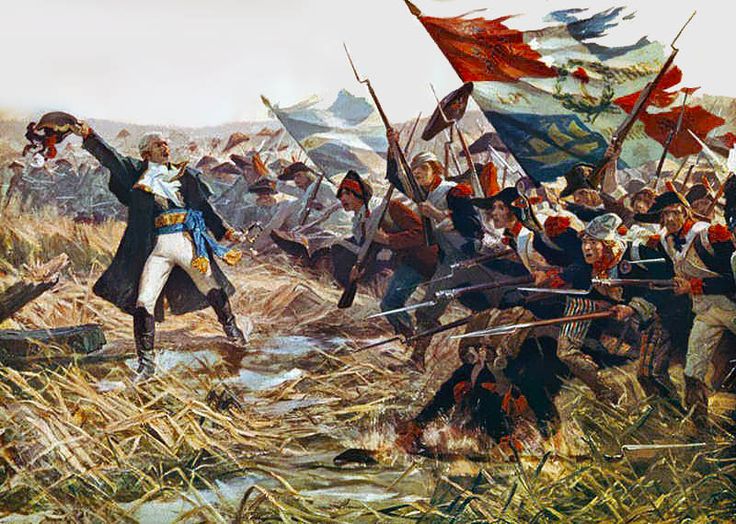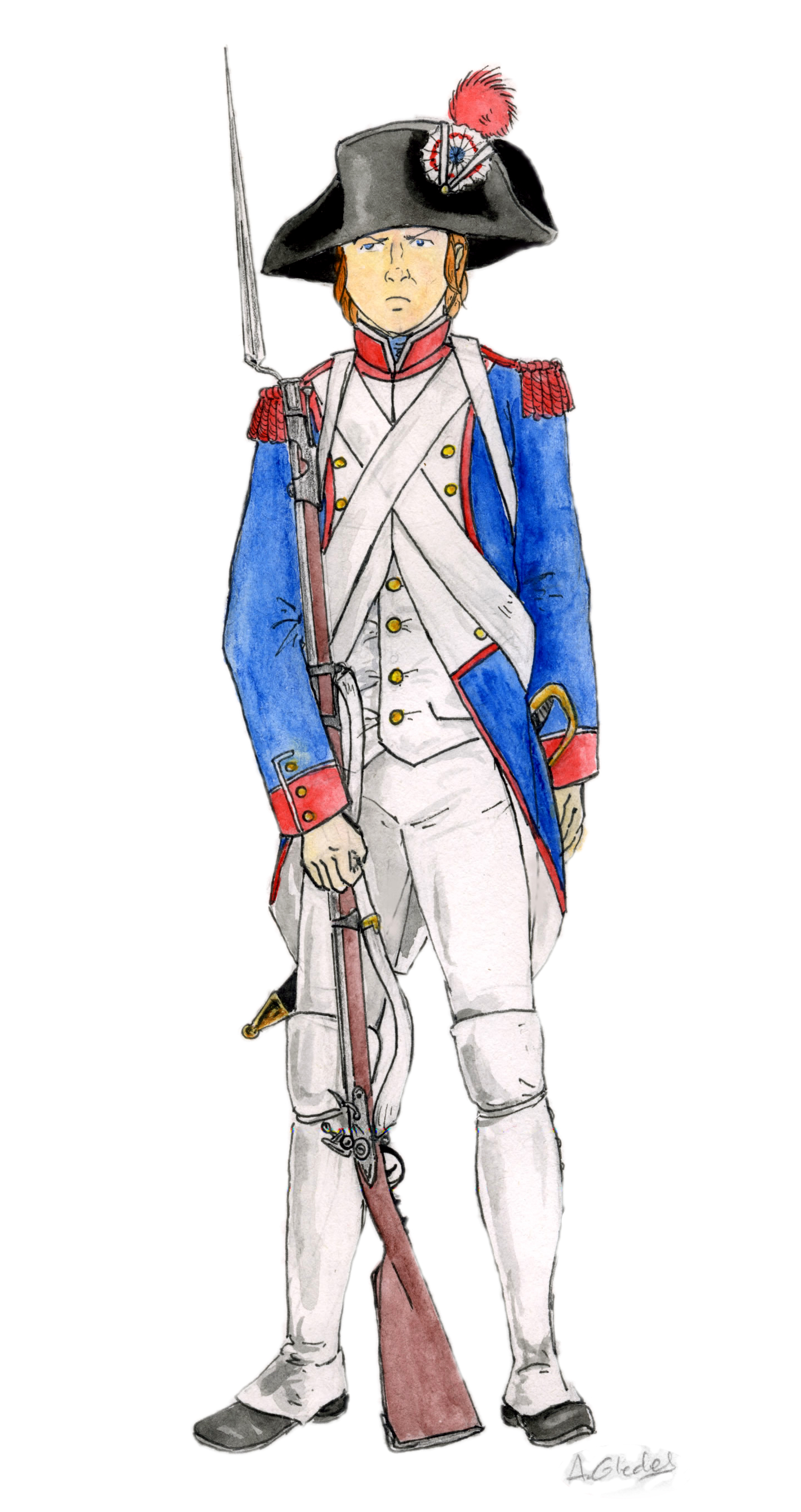|
Chasseurs Bretons
The Breton Chasseurs () was a chasseur battalion of the French Royal Army which was created just before the French Revolution. The battalion would see service in the initial stages of the conflict, but the lineage ended after it was amalgamated with other volunteer units. The battalion's successor, the 81st Infantry Regiment would continue to serve in the modern French Army until 2010 when it was disbanded. Background & Formation Following the 8 August 1784 army ordnance, several regiments of Chasseurs à Cheval''', literally Chasseurs of Horse or Mounted Chasseurs were formed. The infantry companies of these regiments were grouped into four battalions, and attached to their respective regiment, leaving six battalions by the end of the year. However, these new massive regiments proved to be too costly and too 'heavy', so a new ordnance was decreed just four years after their formation.Susane, ''Volume I'', pp. 308–309Crowdy, p. 4Smith, ''Uniforms of the Napoleonic Wars'', ... [...More Info...] [...Related Items...] OR: [Wikipedia] [Google] [Baidu] |
French Royal Army
The French Royal Army (french: Armée Royale Française) was the principal land force of the Kingdom of France. It served the Bourbon Dynasty from the reign of Louis XIV in the mid-17th century to that of Charles X in the 19th, with an interlude from 1792 to 1814 and another during the Hundred Days in 1815. It was permanently dissolved following the July Revolution in 1830. The French Royal Army became a model for the new regimental system that was to be imitated throughout Europe from the mid-17th century onward. It was regarded as Europe's greatest military force and the most powerful armies in the world for much of its existence. History Army of Louis XIV Creation of a professional royal army When Louis XIV came to the French throne in 1661 he inherited a large but loosely organized force of about 70,000 men. Like the other European armies of the period, it consisted of a mixture of mercenaries, guard units, local militias and levies conscripted only for specific campaign ... [...More Info...] [...Related Items...] OR: [Wikipedia] [Google] [Baidu] |
Drum Major (military)
A drum major in the military is the individual leading a military band or a field unit (corps of drums, fanfare band, pipe band or drum and bugle corps). It is an appointment, not a military rank. Military drum majors utilize a ceremonial mace for giving commands while marching. Many drum majors, particularly American- or British-influenced ones, wear a sash that can carry embroidered badges of their home unit and battle honors; a pair of ceremonial drum sticks are often attached. By country Australia The Australian Army traditionally styles the appointments along the same lines as the British Army. The drum major is usually an experienced member of the Australian Army Band Corps, although drum majors in regimental pipes and drums are typically members of the Royal Australian Infantry Corps. Drum majors generally have the rank of a senior NCO. However, capability is the main qualification for appointment: the most senior or highest-ranked member of the unit is not always the dr ... [...More Info...] [...Related Items...] OR: [Wikipedia] [Google] [Baidu] |
National Assembly (France)
The National Assembly (french: link=no, italics=set, Assemblée nationale; ) is the lower house A lower house is one of two Debate chamber, chambers of a Bicameralism, bicameral legislature, the other chamber being the upper house. Despite its official position "below" the upper house, in many legislatures worldwide, the lower house has co ... of the Bicameralism, bicameral French Parliament under the French Fifth Republic, Fifth Republic, the upper house being the Senate (France), Senate (). The National Assembly's legislators are known as (), meaning "delegate" or "envoy" in English; Etymology, etymologically, it is a cognate of the English word ''Deputy (legislator), deputy'', which is the standard term for legislators in many parliamentary systems). There are 577 , each elected by a single-member Constituencies of the National Assembly of France, constituency (at least one per Departments of France, department) through a two-round system; thus, 289 seats are required ... [...More Info...] [...Related Items...] OR: [Wikipedia] [Google] [Baidu] |
Flanders Campaign
The Flanders Campaign (or Campaign in the Low Countries) was conducted from 20 April 1792 to 7 June 1795 during the first years of the War of the First Coalition. A coalition of states representing the Ancien Régime in Western Europe – Austria (including the Southern Netherlands), Prussia, Great Britain, the Dutch Republic (the Northern Netherlands), Hanover and Hesse-Kassel – mobilised military forces along all the French frontiers, with the intention to invade Revolutionary France and end the French First Republic. The radicalised French revolutionaries, who broke the Catholic Church's power (1790), abolished the monarchy (1792) and even executed the deposed king Louis XVI of France (1793), vied to spread the Revolution beyond France's borders, by violent means if necessary. A quick French success in the Battle of Jemappes in November 1792 was followed by a major Coalition victory at Neerwinden in March 1793. After this initial stage, the largest of these for ... [...More Info...] [...Related Items...] OR: [Wikipedia] [Google] [Baidu] |
Bas-Rhin
Bas-Rhin (; Alsatian: ''Unterelsàss'', ' or '; traditional german: links=no, Niederrhein; en, Lower Rhine) is a department in Alsace which is a part of the Grand Est super-region of France. The name means 'Lower Rhine', referring to its lower altitude among the two French Rhine departments: it is downstream of the Haut-Rhin (Upper Rhine) department. Note that both belong to the European Upper Rhine region. It is, with the Haut-Rhin (Upper Rhine), one of the two departments of the traditional Alsace region which until 1871, also included the area now known as the Territoire de Belfort. The more populous and densely populated of the pair, it had 1,140,057 inhabitants in 2019.Populations légales 2019: 67 Bas-Rhin INSEE The [...More Info...] [...Related Items...] OR: [Wikipedia] [Google] [Baidu] |
Army Of The Rhine (1791–1795)
The Army of the Rhine (french: Armée du Rhin) was formed in December 1791, for the purpose of bringing the French Revolution to the German states along the Rhine River. During its first year in action (1792), under command of Adam Philippe Custine, the Army of the Rhine participated in several victories, including Mainz, Frankfurt and Speyer. Subsequently, the army underwent several reorganizations and merged with the Army of the Moselle to form the Army of the Rhine and Moselle on 20 April 1795. Revolutionary Wars The Army of the Rhine (''Armée du Rhin'') was one of the main French Revolutionary armies operated in the Rhineland theater, principally in the Rhine River valley, from 1791 to 1795. At its creation, the Army of the Rhine had 88,390 men. It was formed on 14 December 1791, to defend France's eastern frontier in conjunction with two other armies, the Army of the North and the Army of the Center (name changed in October 1792 to Army of the Moselle). These armies we ... [...More Info...] [...Related Items...] OR: [Wikipedia] [Google] [Baidu] |
Strasbourg
Strasbourg (, , ; german: Straßburg ; gsw, label=Bas Rhin Bas-Rhin (; Alsatian: ''Unterelsàss'', ' or '; traditional german: links=no, Niederrhein; en, Lower Rhine) is a department in Alsace which is a part of the Grand Est super-region of France. The name means 'Lower Rhine', referring to its lowe ... Alsatian dialect, Alsatian, Strossburi , gsw, label=Haut Rhin Alsatian dialect, Alsatian, Strossburig ) is the Prefectures in France, prefecture and largest city of the Grand Est Regions of France, region of Geography of France, eastern France and the Seat of the European Parliament in Strasbourg, official seat of the European Parliament. Located at the France–Germany border, border with Germany in the historic region of Alsace, it is the prefecture of the Bas-Rhin Departments of France, department. In 2019, the city proper had 287,228 inhabitants and both the Eurométropole de Strasbourg (Greater Strasbourg) and the Arrondissement of Strasbourg had 505,272 inhabita ... [...More Info...] [...Related Items...] OR: [Wikipedia] [Google] [Baidu] |
Casque
{{disambiguation ...
Casque is a French word for helmet. It can refer to: * Casque (anatomy), an enlargement on the beaks of some species of birds, including many hornbills *Hornbill ivory, the casque of the helmeted hornbill, collected as a decorative material * S. C. H. "Sammy" Davis (1887–1981), a motor-racing journalist who used the pen name ''Casque'' * ''Casque''-class destroyer, French Navy ships built between 1910 and 1912 See also * Casque and Gauntlet, a senior society at Dartmouth College * Cask (other) * Kask (other) * CASC (other) * KASC (other) KASC may refer to: * KASC-LP, a defunct low-power television station (channel 7) formerly licensed to serve Atascadero, California, United States * KASC (AM), a radio station (1330 AM) at Arizona State University * King Abdullah Sports City See ... [...More Info...] [...Related Items...] OR: [Wikipedia] [Google] [Baidu] |
Saint-Jean-d'Angély
Saint-Jean-d'Angély (; Saintongeais: ''Sént-Jhan-d'Anjhéli'') is a commune in the Charente-Maritime department in southwestern France. The commune has its historical origins in the Abbey of Saint-Jean-d'Angély. Royal abbey Founded in the ninth century to house a relic of Saint John the Baptist, and rebuilt in the 14th, 17th and 18th centuries because of repeated destruction, then later abandoned, the Abbey is now a listed building. It remains the most remarkable piece of architecture of Saint-Jean-d'Angély, a town which has kept all its medieval charm. Situated on the pilgrim route that led to Santiago de CompostelaThe route is registered by the UNESCO as part of the "World Heritage of Humanity" the edifice still constitutes a major stopping-off point towards Santiago de Compostela. Since 1989, the Royal Abbey has housed the Centre of European Culture, which has breathed new life into the Abbey by restoring it as a historical and cultural site and as a place for the exch ... [...More Info...] [...Related Items...] OR: [Wikipedia] [Google] [Baidu] |
Oléron
The Isle of Oléron or Oléron Island (french: île d'Oléron, ; Saintongese: ''ilâte d'Olerun''; oc, illa d'Olairon or ; la, Uliarus insula, ) is an island off the Atlantic coast of France (due west of Rochefort), on the southern side of the Pertuis d'Antioche strait. It is the second largest island of Metropolitan France, after Corsica, with a length of 30 km and a width of 8 km. It has an area of 174 km and more than 21,000 permanent inhabitants. History In the 7th and 8th century, the island, along with Ré, formed the ''Vacetae Insulae'' or Vacetian Islands, according to the '' Cosmographia''. Vaceti being another name for the Vascones, the reference is evidence to Basque (Gascon) settlement or control of the islands by that date. It was at Oléron in about 1152 to 1160 that Eleanor of Aquitaine introduced the first 'maritime' or 'admiralty' laws in that part of the world: the Rolls of Oleron. In 1306, Edward I of England granted the island to his son, ... [...More Info...] [...Related Items...] OR: [Wikipedia] [Google] [Baidu] |






